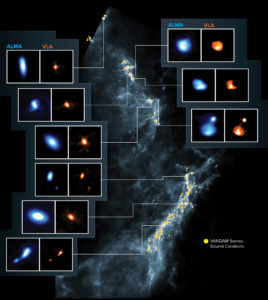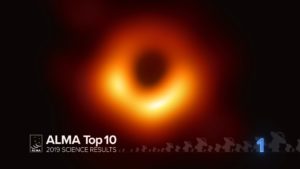Ian Czekala of the University of California at Berkeley explains his research on ‘Tatooine’ protoplanetary disks.


The Turbulent Life of Two Supermassive Black Holes Caught in a Galaxy Crash
NGC 6240 as seen with ALMA. The molecular gas is blue and the black holes are the red dots. This image provides the sharpest view yet of the molecular gas around the black holes in this merging galaxy.

Protostars in Orion Molecular Clouds
This image shows the Orion Molecular Clouds, the target of the VANDAM survey. Yellow dots are the locations of the observed protostars on a blue background image made by Herschel. Side panels show nine young protostars imaged by ALMA (blue) and the VLA (orange).

VANDAM survey
ALMA and the VLA observed more than 300 protostars and their young protoplanetary disks in Orion. This image shows a subset of stars, including a few binaries. The ALMA and VLA data complement each other: ALMA sees the outer disk structure (visualized in blue), and the VLA observes the inner disks and star cores (orange).

01 – ALMA Top 10: Messier 87 The Very First Image of a Black Hole
Astronomers have captured the first direct visual evidence of a black hole: an image of the supermassive black hole at the center of Messier 87 (M87), a giant elliptical galaxy 55 million light-years from Earth. This observation was made possible by the Event Horizon Telescope (EHT), an array of seven individual radio telescopes spread over four continents and linked together to form a new, Earth-size radio telescope.

02 – ALMA Top 10: ALMA Captures Orbital Motion around a Black Hole.
What happens inside a black hole stays inside a black hole, but what happens inside a black hole’s “sphere of influence” – the innermost region of a galaxy where a black hole’s gravity is the dominant force – is of intense interest to astronomers and can help determine the mass of a black hole as well as its impact on its galactic neighborhood.
New observations with the Atacama Large Millimeter/submillimeter Array (ALMA) provide an unprecedented close-up view of a swirling disk of cold interstellar gas rotating around a supermassive black hole. This disk lies at the center of NGC 3258, a massive elliptical galaxy about 100 million light-years from Earth. Based on these observations, a team led by astronomers from Texas A&M University and the University of California, Irvine, have determined that this black hole weighs a staggering 2.25 billion solar masses, the most massive black hole measured with ALMA to date.





